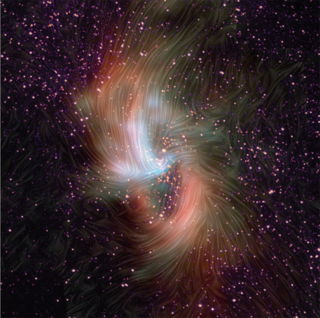Magnetic Fields May Muzzle Milky Way's Monster Black Hole
Magnetic fields may keep the Milky Way's supermassive black hole quiet.

Magnetic forces may explain why the supermassive black hole at the heart of the Milky Way is so much quieter than its counterparts in other galaxies.
New observations, taken by NASA's Stratospheric Observatory for Infrared Astronomy (SOFIA) mission, reveal unprecedented information about the strong magnetic field lines at the center of the galaxy.
The strong gravitational pull of the Milky Way's central black hole, which is known as Sagittarius A*, dominates the heart of the galaxy. In general, as material falls into black holes, the dark giants emit high-energy radiation that reveals their presence. Compared to black holes seen in other galaxies, however, the Milky Way's heart is relatively quiet, emitting far less radiation than expected. Understanding how black holes interact with their magnetic fields can help scientists understand the difference between active and quiet black holes.
Related: Images: Black Holes of the Universe
Whether they exist around refrigerator magnets or black holes, magnetic fields are invisible. To study the ones connected to Sagittarius A*, researchers relied on SOFIA, which is a modified Boeing 747SP aircraft. Specifically, they employed SOFIA's newest instrument, the High-resolution Airborne Wideband Camera-Plus (HAWC+), to track polarized far-infrared light emitted by dust particles.
Because dust grains line up perpendicular to magnetic fields, astronomers were able to map the shape and infer the strength of the magnetic field around the black hole. Combining the new map with mid- and far-infrared images of Sagittarius A* revealed the direction of the magnetic field.
While some of the material from the surrounding ring of gas and dust is falling toward the black hole, the magnetic field also directs material away from the hungry giant, researchers said.
Get the Space.com Newsletter
Breaking space news, the latest updates on rocket launches, skywatching events and more!
"The spiral shape of the magnetic field channels the gas into an orbit around the black hole," HAWC+ principal investigator Darren Dowell, of NASA's Jet Propulsion Laboratory in Pasadena, California, said in a statement.
"This could explain why our black hole is quiet while others are active," added Dowell, lead author of a new study reporting the SOFIA results.
Sagittarius A* is the closest supermassive black hole to the sun and therefore provides a good opportunity to learn how the mysterious giants function.
"This is one of the first instances where we can really see how magnetic fields and interstellar matter interact with each other," said study co-author Joan Schmelz, an astrophysicist at NASA Ames Research Center in California. "HAWC+ is a game-changer."
The results were presented at the 234th semiannual meeting of the American Astronomical Society, which was held this week in St. Louis.
- Photos from SOFIA, NASA's Flying Telescope (Gallery)
- Black Hole Quiz: How Well Do You Know Nature's Weirdest Creations?
- Our Milky Way Galaxy: A Traveler's Guide (Infographic)
Follow Nola on Facebook and on Twitter at @NolaTRedd. Follow us on Twitter @Spacedotcom and on Facebook.
Join our Space Forums to keep talking space on the latest missions, night sky and more! And if you have a news tip, correction or comment, let us know at: community@space.com.

Nola Taylor Tillman is a contributing writer for Space.com. She loves all things space and astronomy-related, and enjoys the opportunity to learn more. She has a Bachelor’s degree in English and Astrophysics from Agnes Scott college and served as an intern at Sky & Telescope magazine. In her free time, she homeschools her four children. Follow her on Twitter at @NolaTRedd
